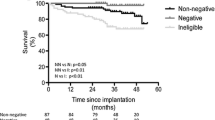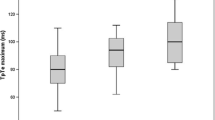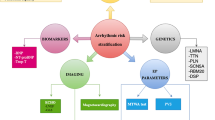Abstract
Aims
Previous studies have demonstrated that microvolt T-wave alternans (TWA) screening in patients with ischaemic and dilated cardiomyopathy is effective in identifying patients at high or low risk of sudden cardiac death. It remains unclear which percentage of potential recipients of an implantable cardioverter defibrillator (ICD) are able to perform TWA testing using an exercise protocol which is, at this moment, the golden standard. In this study, we evaluated the feasibility of TWA in the risk stratification of potential ICD recipients with ischaemic or dilated cardiomyopathy.
Methods and Results
Medical charts of 165 primary prevention ICD recipients were reviewed to decide if patients were able to perform a TWA exercise test or not. Reasons to waiver a test were: atrial fibrillation or flutter, pacemaker dependency, recent (cardiovascular) surgery (<1 month) and inability to exercise. Of the potential ICD recipients 35% had one or more of these contraindications and were therefore not suitable for testing.
Conclusion
In several studies, TWA is a promising risk stratifier for predicting sudden cardiac death; however, in our population, 35% of the potential ICD candidates could not be tested. In order to fulfil its promise as a predictor for SCD, an alternative means to measure TWA needs to be evaluated.
Similar content being viewed by others
References
Zipes DP, Wellens HJ. Sudden cardiac death. Circulation. 1998;98(21):2334–51.
Moss AJ, Hall WJ, Cannom DS, Daubert JP, Higgins SL, Klein H, et al. Improved survival with an implanted defibrillator in patients with coronary disease at high risk for ventricular arrhythmia. Multicenter automatic defibrillator implantation trial investigators. N Engl J Med. 1996;335(26):1933–40.
Bardy GH, Lee KL, Mark DB, Poole JE, Packer DL, Boineau R, et al. Amiodarone or an implantable cardioverter–defibrillator for congestive heart failure. N Engl J Med. 2005;352(3):225–37.
Gehi AK, Stein RH, Metz LD, Gomes JA. Microvolt T-wave alternans for the risk stratification of ventricular tachyarrhythmic events: a meta-analysis. J Am Coll Cardiol. 2005;46(1):75–82.
Chow T, Kereiakes DJ, Onufer J, Woelfel A, Gursoy S, Peterson BJ, et al. Does microvolt T-wave alternans testing predict ventricular tachyarrhythmias in patients with ischemic cardiomyopathy and prophylactic defibrillators? The MASTER (Microvolt T Wave Alternans Testing for Risk Stratification of Post-Myocardial Infarction Patients) trial. J Am Coll Cardiol. 2008;52(20):1607–15.
Gold MR, Ip JH, Costantini O, Poole JE, McNulty S, Mark DB, et al. Role of microvolt T-wave alternans in assessment of arrhythmia vulnerability among patients with heart failure and systolic dysfunction: primary results from the T-wave alternans sudden cardiac death in heart failure trial substudy. Circulation. 2008;118(20):2022–8.
Zipes DP, Camm AJ, Borggrefe M, Buxton AE, Chaitman B, Fromer M, et al. ACC/AHA/ESC 2006 guidelines for management of patients with ventricular arrhythmias and the prevention of sudden cardiac death: a report of the American College of Cardiology/American Heart Association Task Force and the European Society of Cardiology Committee for Practice Guidelines (Writing Committee to Develop guidelines for management of patients with ventricular arrhythmias and the prevention of sudden cardiac death) developed in collaboration with the European Heart Rhythm Association and the Heart Rhythm Society. Europace. 2006;8(9):746–837.
Narayan SM. T-wave alternans and the susceptibility to ventricular arrhythmias. J Am Coll Cardiol. 2006;47(2):269–81.
Gibbons RJ, Balady GJ, Beasley JW, Bricker JT, Duvernoy WF, Froelicher VF, et al. ACC/AHA guidelines for exercise testing: executive summary. A report of the American College of Cardiology/American Heart Association Task Force on Practice Guidelines (Committee on Exercise Testing). Circulation. 1997;96(1):345–54.
Haghjoo M, Arya A, Sadr-Ameli MA. Microvolt T-wave alternans: a review of techniques, interpretation, utility, clinical studies, and future perspectives. Int J Cardiol. 2006;109(3):293–306.
Raatikainen MJ, Jokinen V, Virtanen V, Hartikainen J, Hedman A, Huikuri HV. Microvolt T-wave alternans during exercise and pacing in patients with acute myocardial infarction. Pacing Clin Electrophysiol. 2005;28 Suppl 1:S193–7.
Hohnloser SH, Klingenheben T, Zabel M, Li YG, Albrecht P, Cohen RJ. T wave alternans during exercise and atrial pacing in humans. J Cardiovasc Electrophysiol. 1997;8(9):987–93.
Rashba EJ, Osman AF, Macmurdy K, Kirk MM, Sarang S, Peters RW, et al. Exercise is superior to pacing for T-wave alternans measurement in subjects with chronic coronary artery disease and left ventricular dysfunction. J Cardiovasc Electrophysiol. 2002;13(9):845–50.
Kraaier K, Verhorst PM, van der Palen J, van Dessel PF, Wilde AA, Scholten MF. Microvolt T-wave alternans during exercise and pacing are not comparable. Europace. 2009;11(10):1375–80.
Zipes DP, Jalife J. Cardiac electrophysiology. From cell to bedside, 3 ed. WB Saunders: New York, 2000.
Weber S, Schwab JO. Comparison of microvolt T-wave alternans measurements using atrial pacing compared to atropine administration. Pacing Clin Electrophysiol. 2007;30(12):1487–92.
Nearing BD, Verrier RL. Modified moving average analysis of T-wave alternans to predict ventricular fibrillation with high accuracy. J Appl Physiol. 2002;92(2):541–9.
Sakaki K, Ikeda T, Miwa Y, Miyakoshi M, Abe A, Tsukada T, et al. Time-domain T-wave alternans measured from Holter electrocardiograms predicts cardiac mortality in patients with left ventricular dysfunction: a prospective study. Heart Rhythm. 2009;6(3):332–7.
Author information
Authors and Affiliations
Corresponding author
Rights and permissions
About this article
Cite this article
Kraaier, K., McCracken, T., van der Palen, J. et al. Is T-Wave Alternans Testing Feasible in Candidates for Prophylactic Implantable Defibrillators?. Neth Heart J 19, 6–9 (2011). https://doi.org/10.1007/s12471-010-0053-5
Published:
Issue Date:
DOI: https://doi.org/10.1007/s12471-010-0053-5




